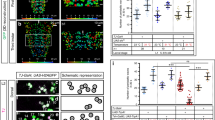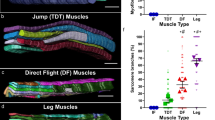Abstract
Different classes of vertebrate motor neuron that innervate distinct muscle targets express unique combinations of LIM-homeodomain transcription factors1,2, suggesting that a combinatorial code of LIM-homeodomain proteins may underlie the control of motor-neuron pathway selection. Studies of LIM-homeodomain genes in mouse, Drosophila melanogaster and Caenorhabditis elegans have revealed functions of these genes in neuronal survival, axon guidance, neurotransmitter expression and neuronal function3,4,5,6,7,8, but, to our knowledge, none of these studies have addressed the issue of a functional code. Here we study two members of this gene family in Drosophila, namely lim3, the homologue of the vertebrate Lhx3 and Lhx4 genes, and islet, thehomologue of the vertebrate Isl1 and Isl2 genes. We show that Drosophila lim3 is expressed by a specific subset of islet-expressing motor neurons and that mutating or misexpressing lim3 switches motor-neuron projections predictably. Our results provide evidence that lim3 and islet constitute a combinatorial code that generates distinct motor-neuron identities.
This is a preview of subscription content, access via your institution
Access options
Subscribe to this journal
Receive 51 print issues and online access
$199.00 per year
only $3.90 per issue
Buy this article
- Purchase on Springer Link
- Instant access to full article PDF
Prices may be subject to local taxes which are calculated during checkout






Similar content being viewed by others
References
Tsuchida, T. et al. Topographic organization of embryonic motor neurons defined by expression of LIM homeobox genes. Cell 79, 957–970 (1994).
Appel, B. et al. Motoneuron fate specification revealed by patterned LIM homeobox gene expression in embryonic zebrafish. Development 121, 4117–4125 (1995).
Way, J. C. & Chalfie, M. mec-3, a homeobox-containing gene that specifies differentiation of the touch receptor neurons in C. elegans. Cell 54, 5–16 (1988).
Thor, S. & Thomas, J. B. The Drosophila islet gene governs axon pathfinding and neurotransmitter identity. Neuron 18, 397–409 (1997).
Lundgren, S. E., Callahan, C. A., Thor, S. & Thomas, J. B. Control of neuronal pathway selection by the Drosophila LIM homeodomain gene apterous. Development 121, 1769–1773 (1995).
Hobert, O., D'Alberti, T., Liu, Y. & Ruvkun, G. Control of neural development and function in a thermoregulatory network by the LIM homeobox gene lin-11. J. Neurosci. 18, 2084–2096 (1998).
Hobert, O. et al. Regulation of interneuron function in the C. elegans thermoregulatory pathway by the ttx-3 LIM homeobox gene. Neuron 19, 345–357 (1997).
Pfaff, S. L., Mendelsohn, C. L., Stewart, C. L., Edlund, T. & Jessell, T. M. Requirement for LIM homeobox gene Isl-1 in motor neuron generation reveals a motor neuron-dependent step in interneuron differentiation. Cell 84, 309–320 (1996).
Wright, T. R. F. in Results and Problems in Cell Differentiation (ed. Hennig, W.) 95–120 (Springer, Heidelberg, (1987).
Lindsley, D. L. & Zimm, G. G. The Genome of Drosophila melanogaster (Academic, San Diego, (1992).
Michelsen, J. W., Schmeichel, K. L., Beckerle, M. C. & Winge, D. R. The LIM motif defines a specific zinc-binding protein domain. Proc. Natl Acad. Sci. USA 90, 4404–4408 (1993).
Michelsen, J. W. et al. Mutational analysis of the metal sites in an LIM domain. J. Biol. Chem. 269, 11108–11113 (1994).
Surdej, P. & Jacobs-Lorena, M. Developmental regulation of bicoid mRNA stability is mediated by the first 43 nucleotides of the 3′ untranslated region. Mol. Cell. Biol. 18, 2892–2900 (1998).
Landgraf, M., Bossing, T., Technau, G. M. & Bate, M. The origin, location, and projections of the embryonic abdominal motorneurons of Drosophila. J. Neurosci. 17, 9642–9655 (1997).
Sink, H. & Whitington, P. M. Location and connectivity of abdominal motoneurons in the embryo and larva of Drosophila melanogaster. Neurobiol. 22, 298–311 (1991).
Jan, L. Y. & Jan, Y. N. Antibodies to horseradish peroxidase as specific neuronal markers in Drosophila and grasshopper embryos. Proc. Natl Acad. Sci. USA 79, 2700–2704 (1982).
Van Vactor, D., Sink, H., Fambrough, D., Tsoo, R. & Goodman, C. S. Genes that control neuromuscular specificity in Drosophila. Cell 73, 1155–1164 (1993).
Brand, A. H. & Perrimon, N. Targeted gene expression as a means of altering cell fates and generating dominant phenotypes. Development 118, 401–415 (1993).
Lin, D. M. & Goodman, C. S. Ectopic and increased expression of Fasciclin II alters motorneuron growth cone guidance. Neuron 13, 507–523 (1994).
Jurata, L. W., Pfaff, S. L. & Gill, G. N. The nuclear LIM domain interactor NLI mediates homo- and heterodimerization of LIM domain transcription factors. J. Biol. Chem. 273, 3152–3157 (1998).
Morcillo, P., Rosen, C., Baylies, M. K. & Dorsett, D. Chip, a widely expressed chromosomal protein required for segmentation and activity of a remote wing margin enhancer in Drosophila. Genes Dev. 11, 2729–2740 (1997).
Liem, K. F. J., Tremml, G. & Jessell, T. M. Arole for the roof plate and its resident TGFβ-related proteins in neuronal patterning in the dorsal spinal cord. Cell 91, 127–138 (1997).
Sharma, K. et al. Lhx3 and Lhx4 assign identities for motor neurons projecting axons ventral from the neural tube. Cell (in the press).
Kalionis, B. & O'Farrell, P. H. Auniversal target sequence is bound in vitro by diverse homeodomains. Mech. Dev. 43, 57–70 (1993).
Brown, N. H. & Kafatos, F. C. Functional cDNA libraries from Drosophila embryos. J. Mol. Biol. 203, 425–437 (1988).
O'Keefe, D. D., Thor, S. & Thomas, J. B. Function and specificity of LIM domains in Drosophila nervous system and wing development. Development 125, 3915–3923 (1998).
Callahan, C. A. & Thomas, J. B. Tau-β-galactosidase, an axon-targeted fusion protein. Proc. Natl Acad. Sci. USA 91, 5972–5976 (1994).
Hiromi, Y. & Gehring, W. J. Regulation and function of the Drosophila segmentation gene fushi tarazu. Cell 50, 963–974 (1987).
Rubin, G. M. & Spradling, A. C. Genetic transformation of Drosophila with transposable element vectors. Science 218, 348–353 (1982).
Callahan, C. A., Yoshikawa, S. & Thomas, J. B. Tracing axons. Curr. Biol. 8, 582–586 (1998).
Acknowledgements
We thank C. S. Goodman for the ftzng-GAL4 flies and anti-fasciclin II antibody; S.Yoshikawa for the UAS-tau-myc-GFP flies; the Midamerica, Umea and Bloomington Stock Centers for providing fly stocks; L. W. Jurata and G. N. Gill for sharing unpublished results; K. Bishop and members of our laboratory for providing advice and technical assistance; and S. Pfaff, K. Sharma, G.Lemke and D. van Meyel for critical review of the manuscript. This work was supported by grants from the NIH and a Pew Scholars Award from the Pew Memorial Trusts (to J.B.T.), an EMBO Long Term Fellowship (to S.G.E.A.) and an HFSP Long-term Fellowship (to S.T.).
Author information
Authors and Affiliations
Rights and permissions
About this article
Cite this article
Thor, S., Andersson, S., Tomlinson, A. et al. A LIM-homeodomain combinatorial code for motor-neuron pathway selection. Nature 397, 76–80 (1999). https://doi.org/10.1038/16275
Received:
Accepted:
Issue Date:
DOI: https://doi.org/10.1038/16275
This article is cited by
-
Accelerated evolution of an Lhx2 enhancer shapes mammalian social hierarchies
Cell Research (2020)
-
Embryonic development of selectively vulnerable neurons in Parkinson’s disease
npj Parkinson's Disease (2017)
-
Interactions between LHX3- and ISL1-family LIM-homeodomain transcription factors are conserved in Caenorhabditis elegans
Scientific Reports (2017)
-
Tissue-specific transcription of the neuronal gene Lim3 affects Drosophila melanogaster lifespan and locomotion
Biogerontology (2017)
-
Developmental origins of diversity in cerebellar output nuclei
Neural Development (2014)
Comments
By submitting a comment you agree to abide by our Terms and Community Guidelines. If you find something abusive or that does not comply with our terms or guidelines please flag it as inappropriate.



